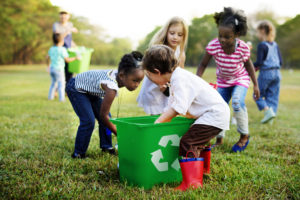
Blog
Tackling America’s Next Moon Shot
On May 25, 1961, President Kennedy stood before Congress and announced the United States’ plan to send a man to the moon before the end of the decade. His words inspired a nation and just eight years later, the world watched as Apollo 11 made good on the president’s promise.
Today, Americans see the need for another moon shot, though this one keeps us on Earth. A new report from the Consumer Brands Association finds that 77 percent of Americans believe that the federal government should make solving the recycling crisis the next “moon shot,” bringing all stakeholders — CPG companies, NGOs, government officials and even consumers — together to find a long-term solution.
Our current patchwork of nearly 10,000 different recycling systems across the country, all with their own unique rules, is causing immense consumer confusion, ultimately leading to higher contamination rates. CPG companies are making great strides to make packaging fully recyclable. But if recyclable containers don’t actually end up recycled, it becomes just one more piece of trash that will end up in a landfill, on the side of the road or in our oceans.
It is not that Americans don’t care — they overwhelmingly do. Concern for the environment and over single-use plastic and packaging waste is extremely high, according to our research. So too is willingness to change. A near-universal 95 percent of respondents said they would change their behavior if they discovered they were recycling the wrong way.
Unfortunately, it is difficult to know. Most Americans assume recycling is relatively standardized; 55 percent said that there were fewer than 100 systems, when in truth there are more than 100 times that many. The sheer diversity of rules in a fragmented system also makes consumer education difficult. Ninety-five percent of Americans said it would be helpful if packaging were labeled with information on how to properly recycle it, but without uniform rules that apply across the country, the current recycling system makes product labels with accurate recycling information for a consumer’s location nearly impossible.
Ninety-three percent of Americans said that uniform, national standards will alleviate confusion about what can be recycled. The seemingly simple fix is anything but. Most Americans acknowledge getting to national standards will be difficult, but also that they are necessary for a lasting fix.
Seventy-seven percent of Americans believe that the federal government should make solving the recycling crisis the next “moon shot.”
Despite its flaws, recycling is still the most likely environmental behavior for most people — far outpacing things like composting or taking public transportation — making it the behavior that has the greatest impact potential. Now is the time to double-down on recycling, not back away from it. Those Americans who have experienced negative changes to their recycling programs, whether reducing accepted materials or cutting it entirely, serve as a cautionary tale of what happens if we back away from recycling on a broader scale: they are twice as likely to give up recycling entirely if they found out their recyclables were being landfilled.
Ninety-three percent of Americans said that uniform, national standards will alleviate confusion about what can be recycled.
When Neil Armstrong took those first steps on the moon, he crossed the finish line of the space race. Now, we are in a race once again. But this one isn’t against the Soviets — it’s against time. And time is running out.
Published on November 12, 2019



